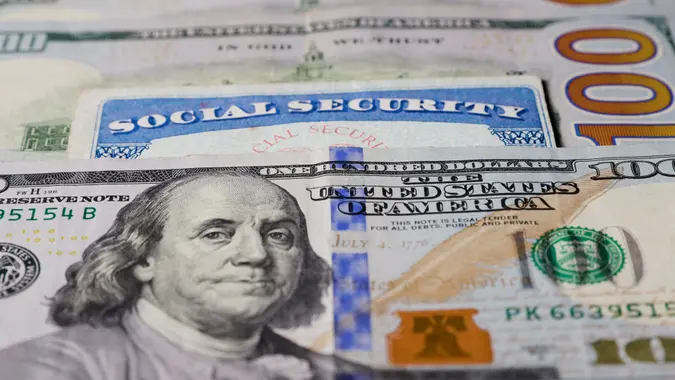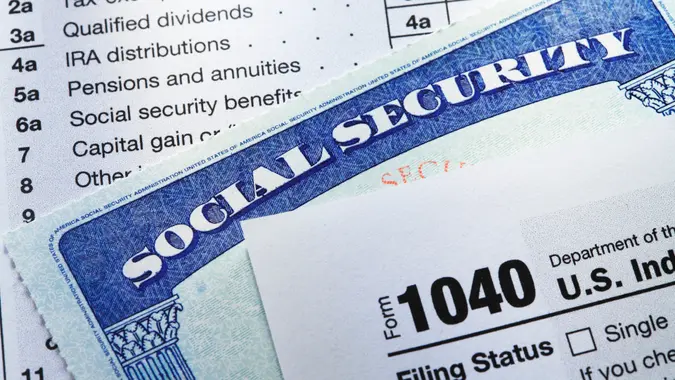Social Security Checks: How Much Does a Middle-Class Retiree Get?

Commitment to Our Readers
GOBankingRates' editorial team is committed to bringing you unbiased reviews and information. We use data-driven methodologies to evaluate financial products and services - our reviews and ratings are not influenced by advertisers. You can read more about our editorial guidelines and our products and services review methodology.

20 Years
Helping You Live Richer

Reviewed
by Experts

Trusted by
Millions of Readers
Middle-class Americans leaving the workforce and entering their golden years have to equip themselves for a major life change. Whether you plan to retire and take the leap soon or decades from now, saving for retirement and being financially prepared is necessary.
Whatever retirement systems you have in place, you’ll still want to know how much you may receive in Social Security benefits each month. This can help you determine the amount of additional savings you’ll need to maintain a comfortable lifestyle.
Your lifetime earnings and the age at which you decide to retire are the two main factors that define the size of your monthly Social Security check. Benefits payments are also adjusted annually to reflect any cost-of-living adjustment (COLA), as measured by the Consumer Price Index.
Here are a few key takeaways from the Social Security Administration (SSA) for 2025:
- As of January 2025, the average Social Security check for a retired worker is estimated to be around $1,976 per month.
- This reflects a 2.5% COLA increase from 2024.
- The average monthly benefit is expected to increase by around $49 compared to 2024.
Keep reading for a closer look at what a middle-class retiree’s Social Security check could look like.
Average Monthly Social Security Benefit of a Middle-Class Retiree
According to the most recent data from the U.S. Census Bureau, the median household income in the U.S. is estimated to be $80,610. Assuming a middle-class retiree earned this salary and retired at age 65 — specifically 65 and 11 months — their Social Security benefit would be $2,088 per month as estimated by the Social Security Administration’s benefit calculator.
Keep in mind that these are just estimates and you should enter your personal information into the calculator to get a more accurate prediction for your retirement plan.
This puts the average middle-class social security check slightly higher than the average benefits approximated for all retirees. However, it’s good to note that if you expect to work longer and wait until age 70, your monthly benefits will increase.
Defining Middle Class
While the number of people who consider themselves middle class is shrinking, it is still the group the majority of Americans feel they fit into. Though the definition does have economic parameters, the feeling of comfort is dwindling thanks to factors such as difficulty with paying off debt or not having enough money to set aside for retirement accounts.
Generally speaking, the number of people who identify as middle class has declined since the Great Recession in 2008. Specifically, 61% of people considered themselves middle or upper-middle class from 2002-2008. Here are some insights from the Pew Research Center:
- The share of Americans who are in the middle class is smaller than it used to be. In 1971, 61% of Americans lived in middle-class households.
- By 2023, the share had fallen to 51% as many Americans are further apart financially.
- The increase in the share of Americans who live in upper income households was greater than the share who lived in lower income households, a sign of overall economic progress.
Can You Survive on a Middle-Class Social Security Check?
If you’re planning to live solely on your Social Security income, this probably isn’t the best idea. Retirees need approximately 70%-80% of their pre-retirement income to uphold their standard of living, and this benefit only replaces around 40% of that, according to the SSA.
Most people ages 60 and up — 87% — have at least some retirement savings, according to the Federal Reserve. However, only 52% believe their retirement savings strategy is on track.
Among retirees age 65 and up, 92% cite Social Security as a source of income. Two-thirds receive a pension, nearly half collect interest, dividends or rental income, one-quarter rely on wages, salaries or self-employment and 7% get cash transfers other than Social Security.
When you add the anticipated cost of rent, healthcare, groceries, utilities and other living expenses the average Social Security check of a middle-class retiree doesn’t cut it. This, of course, doesn’t include any other expenses, such as entertainment, clothing, transportation and travel.
Simply put, your monthly Social Security check will provide you with money that can help pay the bills. However, you’ll need supplemental forms of income to enjoy the comfortable, relaxing and greatest retirement you deserve.
Jennifer Taylor contributed to the reporting for this article.
 Written by
Written by  Edited by
Edited by 
























